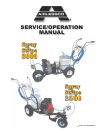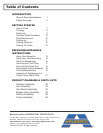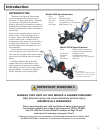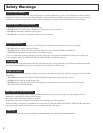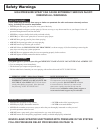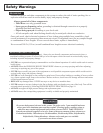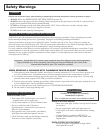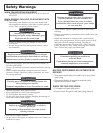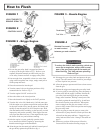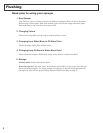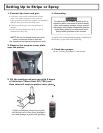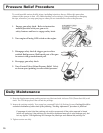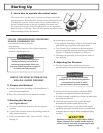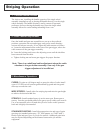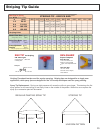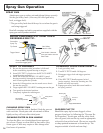
TIP GUARD
ALWAYS have the tip guard in place on the spray gun while spraying. The tip guard alerts you to the injection hazard and helps
prevent accidentally placing your ngers or any part of your body close to the spray tip.
SPRAY TIP SAFETY
Use extreme caution when cleaning or changing spray tips. If the spray tip clogs while spraying, engage the gun safety latch
immediately.
• ALWAYS follow the PRESSURE RELIEF PROCEDURE and then remove the spray tip to clean it.
• NEVER wipe off build up around the spray tip.
• ALWAYS remove tip & tip guard to clean AFTER pump is turned off and the pressure is relieved by following the
PRESSURE RELIEF PROCEDURE.
KEEP CLEAR OF MOVING PARTS
Keep clear of moving parts when starting or operating the sprayer. Do not put your ngers into any openings to avoid
amputation by moving parts or burns from hot parts.
Precaution is the best insurance against an accident.
When starting the engine, maintain a safe distance from moving parts of the equipment.
Before adjusting or servicing any mechanical part of the sprayer, follow the PRESSURE RELIEF PROCEDURE, and remove
the ignition cable from the spark plug to prevent accidental starting of the sprayer.
ALWAYS INSPECT SPRAYING AREA
• ALWAYS keep spraying area free from obstructions.
• ALWAYS make sure area has good ventilation to safely remove vapors and mists.
• NEVER keep ammable material in spraying area.
• NEVER spray in vicinity of open ame or other sources of ignition.
SPRAY GUN SAFETY
• ALWAYS set safety lock on the gun in "LOCKED" position when not in use and before servicing or cleaning.
• NEVER remove or modify any part of the gun.
• ALWAYS REMOVE SPRAY TIP when cleaning. Flush unit with LOWEST POSSIBLE PRESSURE.
• ALWAYS check operation of all gun safety devices before each use.
• Be very careful when removing the spray tip or hose from gun. A plugged line contains uid under pressure. If the tip or
line is plugged, follow the PRESSURE RELIEF PROCEDURE as outlined on page 10.
Safety Warnings
Keep all labels on the unit clean and readable. Replacement labels are available from the manufacturer.
LABELING
Hazardous uid or toxic fumes can cause serious injury or death if splashed in eyes or on skin, inhaled or swallowed. Know
the hazards of the uid you are using. Store & dispose of hazardous uids according to manufacturer, local, state & national
guidelines. ALWAYS wear protective eye wear, gloves, clothing and respirator as recommended by uid manufacturer.
TOXIC FLUID HAZARD
2



